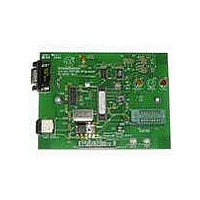PG103003 Microchip Technology, PG103003 Datasheet - Page 2

PG103003
Manufacturer Part Number
PG103003
Description
KIT PROGRAMMERS MICROID 13.56MHZ
Manufacturer
Microchip Technology
Series
MicroID®r
Type
MicroID®r
Datasheet
1.PG103003.pdf
(22 pages)
Specifications of PG103003
Contents
Programmer, Power Supply, Cable(s) and Software
Product
RFID Kits
Lead Free Status / RoHS Status
Lead free / RoHS Compliant
For Use With/related Products
MCRF355, MCRF360
Lead Free Status / RoHS Status
Lead free / RoHS Compliant, Lead free / RoHS Compliant
MCRF355
Description
The MCRF355 is Microchip’s uniquely designed read-
only passive Radio Frequency Identification (RFID)
device with an advanced anti-collision feature. It is
programmable with a contact programmer or factory
programming only. The device is powered remotely by
rectifying RF magnetic fields that are transmitted from
the reader.
The device has a total of six pads (see Figure 1-1).
Three (ant. A, ant. B, V
external resonant circuit elements. The additional three
pads (V
testing of the device.
The device needs an external resonant circuit between
antenna A, B, and V
of the circuit is determined by the circuit elements
between the antenna A and V
circuit must be tuned to the carrier frequency of the
reader for maximum performance. The circuit element
between the antenna B and V
modulation. See Application Note AN707 for further
operational details. Examples of the resonant circuit
configuration for the MCRF355 are shown in
Section 3.0.
When a tag (device with the external LC resonant
circuit) is brought to the reader’s RF field, it induces an
RF voltage across the LC resonant circuit. The device
rectifies the RF voltage and develops a DC voltage.
The device becomes functional as soon as V
reaches the operating voltage level.
The device includes a modulation transistor that is
located between antenna B and V
tor has high turn-off (a few M
resistance. The turn-on resistance is called modulation
resistance (R
onant circuit is tuned to the carrier frequency of the
reader. This condition is called uncloaking. When the
modulation transistor turns on, its low turn-on resis-
tance shorts the external circuit element between
antenna B and V
longer resonates at the carrier frequency. This is called
cloaking.
The induced voltage amplitude (on the resonant circuit)
changes with the modulation data: higher amplitude
during uncloaking (tuned), and lower amplitude during
cloaking (detuned). This is called “amplitude modula-
tion” signal. The receiver channel in the reader detects
this amplitude modulation signal and reconstructs the
modulation data.
The occurrence of the cloaking and uncloaking of the
device is controlled by the modulation signal that turns
the modulation transistor on and off, resulting in com-
munication from the device to the reader.
DS21287G-page 2
PRG
, CLK, V
M
). When the transistor turns off, the res-
SS
. As a result, the resonant circuit no
DD
SS
) are used for programming and
pads. The resonant frequency
SS
) are used to connect the
SS
SS
and low turn-on (3 )
pads is used for data
SS
pads. The resonant
pads. The transis-
DD
The data stream consists of 154 bits of Manchester-
encoded data at a 70 kHz rate. The Manchester code
waveform is shown in Figure 2-2. After completion of
the data transmission, the device goes into SLEEP
mode for about 100 ms. The device repeats the trans-
mitting and SLEEP cycles as long as it is energized.
During the SLEEP time, the device remains in an
uncloaked state.
SLEEP time is determined by a built-in, low-current
timer. There is a wide variation of the SLEEP time
between each device. This wide variation of SLEEP
time results in a randomness of the time slot. Each
device wakes up and transmits its data in a different
time slot with respect to each other. Based on this
scenario, the reader is able to read many tags that are
in the same RF field.
The device has a total of 154 bits of reprogrammable
memory. All bits are reprogrammable by a contact
programmer. A contact programmer (part number
PG103003) is available from Microchip Technology Inc.
Factory programming prior to shipment, known as
Serialized Quick Turn Programming
also available. The device is available in die, wafer,
wafer-on-frame, PDIP and SOIC packages.
Note:
Information provided herein is subject to
change without notice.
© 2005 Microchip Technology Inc.
SM
(SQTP
SM
), is











